Sammy Carlson is no stranger to the spotlight. But after competing at freeskiing’s highest stage, the Oregon native now feels most inspired filming far from distractions in the mountains of British Columbia. There, while working on his current project, Resilience, he’s continuing to define what’s possible in powder.
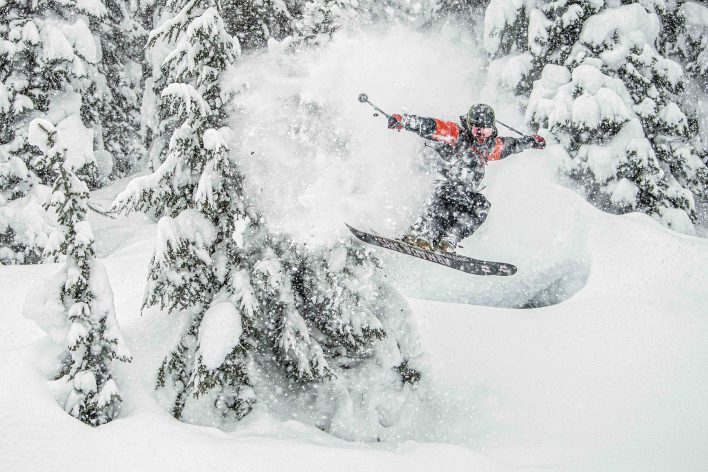
There’s an expectation these days that professional athletes have an online presence—brands need to justify marketing spends on sponsorships, and fans want a virtual backstage pass to the show. The problem is Sammy Carlson’s typical worksite—deep in the pillowed crannies of British Columbia—is far from cell service. And his job requires undivided focus.
For those unacquainted with the Oregonian park skier turned British Columbian recluse, Sammy Carlson boasts a remarkable résumé. The 31-year-old freeskier has dropped banger film segments since age 12, most famously starring in Teton Gravity Research’s 2015 The Sammy C Project. He pioneered the switch triple rodeo 1260 in 2010, which later earned him “Best Manmade Air” at the 2011 Powder Video Awards. He has eight X Games medals to his name, including a gold in slopestyle from Aspen in 2011. But when slopestyle debuted at the 2014 Olympic Games, Carlson wasn’t interested.
“As a skier, I felt the next step was going out into the backcountry and continuing to push myself in the mountains,” he says. He followed his gut, although he didn’t completely abandon competition, winning three times the X Games Real Ski Backcountry contest, an invite-only freeski film shootout, from 2013 to 2015.
While it’s helpful to chart Carlson’s career, the laundry list of awards doesn’t capture just how widespread and significant his impact on skiing truly is. Freeski legend Tanner Hall might best describe his Armada’ teammate’s trajectory. “The student has become the teacher,” he says. “When he put out On Top of The Hood (2011), that’s where it really started for me, where I was like, ‘Holy shit, you’re the best in the world right now.’ And it hasn’t really slowed down.”
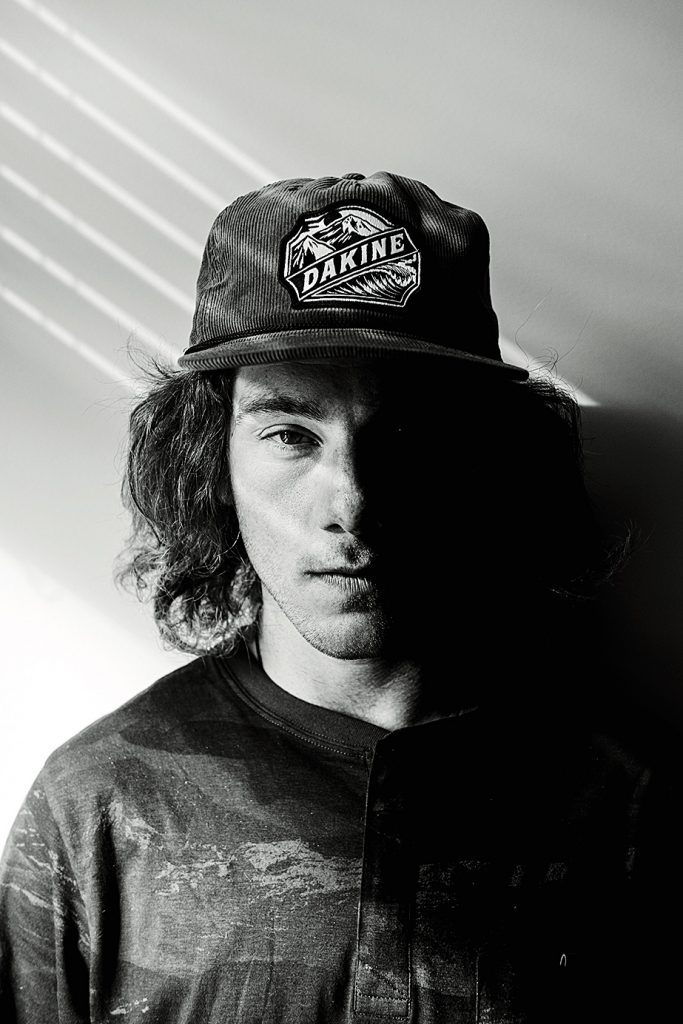
Carlson has remained both hungry and humble. Between favorable filming windows, when he slips off the radar for days at a time, and his disinterest in social media and regular communication, however, he’s not easy to track down mid-winter. We first met at an event in January in Vail, Colorado, and, after an interview in a rental truck while we drove to Denver International Airport together, I planned to spend five days in February hanging around in Revelstoke, Carlson’s winter home, hoping to link up with him for a day or two of filming and to glean insight into a man content to let his skiing speak for itself.
Still, when February rolled around and I boarded the flight from my home in Salt Lake City, Utah, to the Kelowna International Airport, I was concerned we’d never connect and my trip to Revelstoke might be a bust.
I’M YANKING OFF MY BOOTS in the parking lot after a dreamy welcome to Revelstoke at K3 Cat Ski when my phone buzzes. It’s an unknown number depositing a typo-ridden text from a satellite messenger, listing a time and place with the instructions: “Just grab beer, American spirits, 10 chocolate bars, and you’re touring gear… And please don’t tell anyone. Taking you to our secret stadh.”
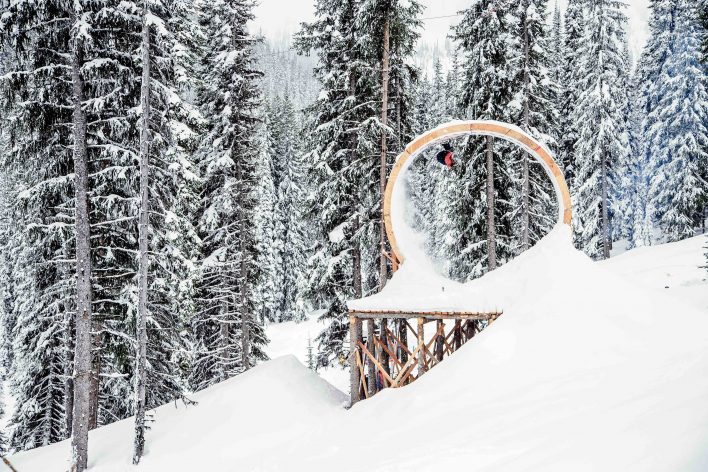
My adrenaline spikes as I plug in the coordinates to the stadh—or stash—and jet to a grocery store that doesn’t sell smokes or suds. I stock up on chocolate, hoping that’s sufficient. Darkness falls as I drive for redacted miles to redacted. Anxious, I park, fruitlessly check my phone for service and regret canceling my hotel room. A few moments later, a pickup pulls in, with Oregon plates and a stickered sled in the bed. Carlson steps out, grinning.
“You made it,” he says. We slap hands, and I try to hide my relief.
After the pleasantries, his smile disappears. “You’ve got to promise you don’t write about this,” he says, gesturing around at our location. The drive, the distance, any landmarks or peak names—all must be kept quiet. For a moment, the whole thing feels like a drug deal, as if I’m about to deliver my chocolate bars to El Patrón. I half expect Carlson to hand me a blindfold and say, “Get in.”
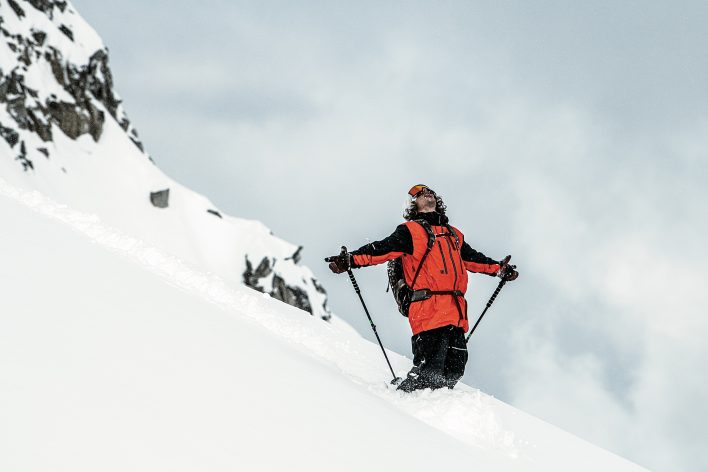
WE SPEND THE NIGHT at a half-finished hideaway of a friend of Sammy’s whom we’ll call Santiago. Boots and skins dry above the hearth, and CK9 Studios director Clay Mitchell and producer Simon Shave review select shots from the day. Both got their start and met Carlson in 2018 while working with Sherpas Cinema, before opening their own shop in Nelson, B.C., in 2019.
Carlson’s filming philosophy, he says, is simple: “Stack A-clips, then turn the A-clips into B-clips,” essentially upping the ante all season long. When I asked Carlson about filming Over Time back in January, which runs just over seven minutes, he reveals that 13 terabytes of footage didn’t make the cut. Fireside, the crew discusses plans for tomorrow: where to go and when, how the light will hit this or that pillow stack.
“You good with a 5:30 alarm?” Carlson asks, as I shuffle toward a narrow mattress on the floor with cartoon character sheets. I nod, but as I drift off, I remember something Carlson said in our conversation back in Colorado, as he navigated I-70 traffic: “Last year, we were setting the clocks one hour ahead to get an extra hour of light out of the film days. It just feels a bit better waking up at 5:30 than 4:30.”
What seems suspiciously like moments later, we’ve made coffee, scarfed breakfast and loaded gear. Snowmobiles roar to life. Inexperienced, I ride tandem with Carlson and try not to mess up.
We roll out in golden light, and all of the secrecy suddenly makes sense: Three-story pillow stacks appear a quick brap from the cabin. “Welcome to paradise,” Carlson says. The snow is deep and stable, and the boys turn a blanketed meadow beneath the pillows into a maze of tracks.
This zone calls for afternoon light, so we continue onward. Around a bend, a curved, glittering amphitheater comes into view. To looker’s right, approximately 1,200-feet tall, a steep, cornice-crowned face is adorned with cliffs and pillows and enough spines to make up a scaled-down Alaska. Looker’s left, an open bowl funnels to a cliff-lined bench. Carlson, seeing the look on my face, laughs.
“When you roll around the corner and see the zone, eh? How beautiful is that?” he says, the “eh”—a linguistic souvenir from years spent in B.C.—sounding natural. “This is what powder dreams are made of, right here.”
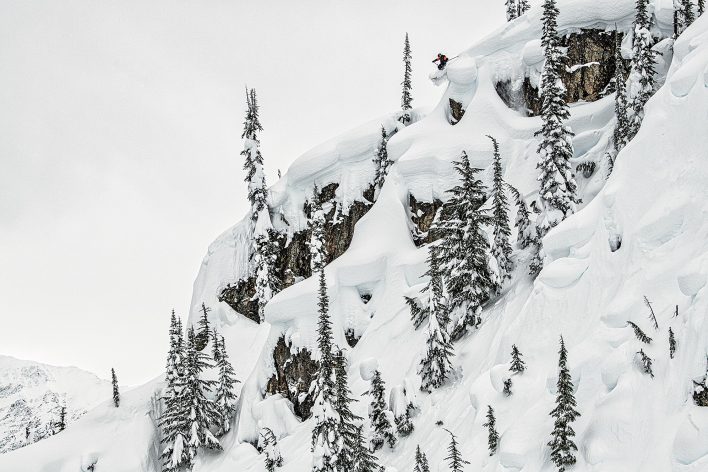
From our base camp of sleds and camera gear, Carlson scopes a potential jump on the bench before getting a shuttle to the top. He skis down the bowl with Mitchell a pole-length away, shooting the close-up pow turns and butters that earned Over Time “Best Cinematography” accolades from Powder in 2019.
Carlson is at the vanguard of a powder-turn renaissance, and his films have helped redefine the simple act of turning on skis. “I’ve been drawing inspiration from surfing and snowboarding,” he says when we catch up later in the fall. “Just to put my own flavor on it.” He experiments with the way he weights his skis and the lines he takes in and out of his turns; he airs into pillows sideways, wielding skis like scimitars.
“You’re not getting any pole plants and figure eights out of that guy, that’s for sure,” says Shave, who enjoys courtside seats to Carlson’s ever-evolving turns. “He just doesn’t do the ‘dad turn.’”
“He’s got that touch,” Hall says of Carlson’s style.
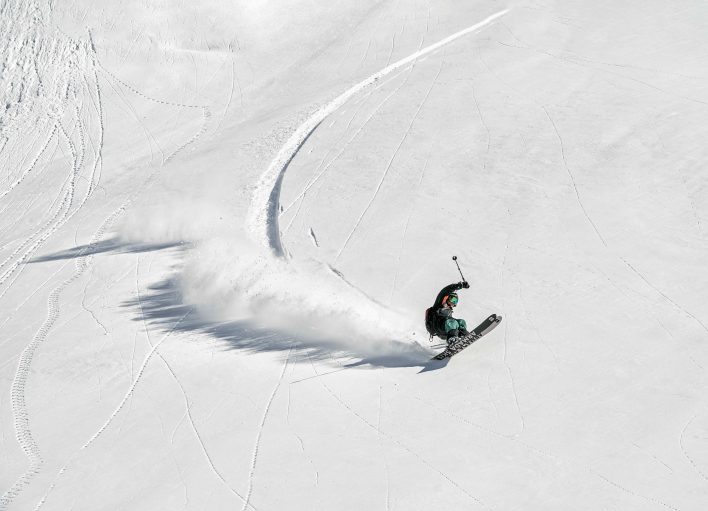
Once Carlson surfs his way into the gut of the amphitheater, he stomps out a lip above the bench—what he calls “terrain enhancement”—and chucks snowballs at the landing below. Suddenly, he’s ready. Mitchell mans the camera, Shave pilots a drone and Carlson counts down. He drops switch, hits the lip, pops and, with characteristic control, contorts into a tweaked double cork 900. At the apex of his two-and-a-half off-axis rotations, he spins as if in moon gravity, then speeds back to Earth. He slashes past Mitchell, a resolute grin on his face.
“What’s going through your head up there?” I ask, baffled by the lack of warmup.
“Just thinking about speed and building the confidence,” he replies as the phone in his jacket pocket blares the song Dr. Birds by the East Coast rap collective Griselda, to which notorious hip-hop head Henrik Harlaut introduced Carlson. He’s nodding, tapping into the gritty, hostile New York flow. It’s rap you won’t hear on the radio: cryptic, complex, inspired by the golden era ’90s but unapologetically now—much like Carlson’s own brand of skiing.
Confidence, I presume, is necessary when throwing double corks in tech bindings. Even on sled days like today, Carlson rides skis mounted with Marker Kingpins and is unafraid to set a skinner. When Santiago judges the amphitheater shuttle-friendly, Carlson dumps his skins and jokes, “Suitcase is light today, boys!” He says it in jest, but there’s truth to it: Backcountry skiing is now his job.
Carlson’s backcountry journey has been an evolution from building kickers to riding smaller lines to putting together the larger pieces of the puzzle. But progressing in the backcountry differs from doing so in the park. “When you drop into a halfpipe, you’re not worried about the whole thing collapsing,” says Carlson, who’s pursuing both a formal avalanche education and soaking up knowledge from the guides and fellow pros with whom he’s been privileged to shoot. TGR also hosts an International Pro Riders Workshop, an annual gathering of their athletes to learn and practice mountain safety skills, which Carlson has attended several times.
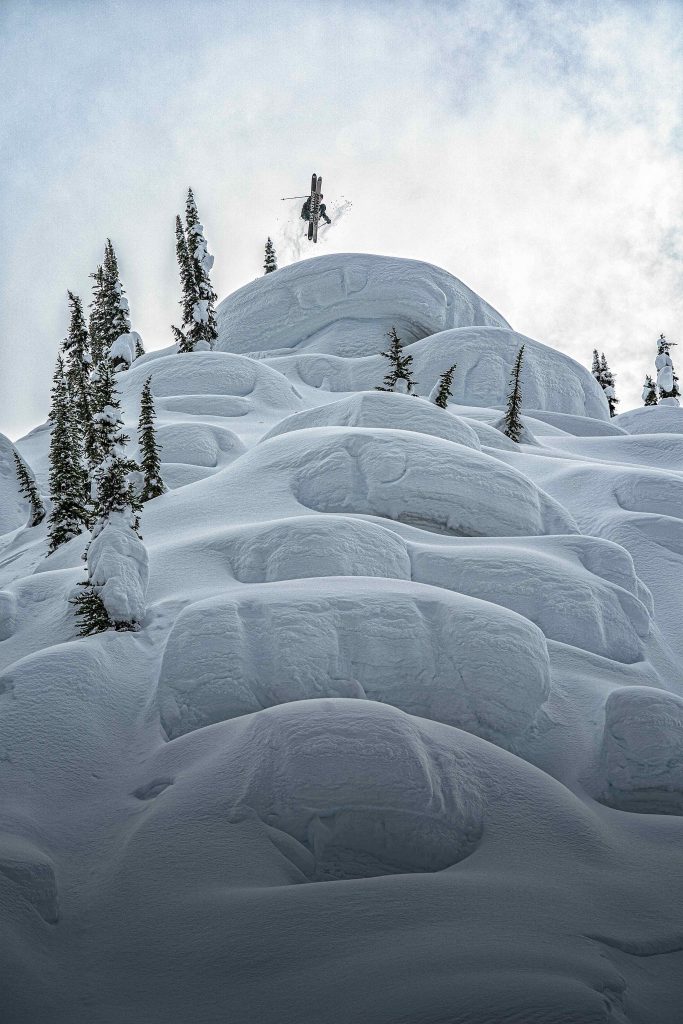
“My first [TGR] trips to Alaska skiing with Sage Cattabriga-Alosa and Ian McIntosh definitely helped me learn,” he says. “Zahan Billimoria…he’s been a mentor of mine. He helped me in a big way with understanding avalanche safety and relating what I’ve learned in the classroom in the field.”
The rap fades as Santiago shuttles Carlson to the top of the ridge again, from where he drops in, throws the same trick and stomps it. Then he does it again.
“I love when it lines up,” says Carlson, looking back at his tracks, not a flake out of place. “Feels good. Just gotta believe. Don’t doubt. Erase any negativity.”
Carlson turns to the twisted, techy knob to looker’s right. The motion echoes a decade-long quest to leave parks behind but take the tricks with him.
“I like these center fingers in there, eh?” he says, hashing out lines and camera angles. Then, once more, he’s at the top, counting down and dropping. He hops off the cornice, slicing down a spine, thrusting tips and tails into thin air. He gets white-roomed above exposure, then launches out of the cloud, composed and compact. Like the 900s, he lands the drop smoothly.
“He’s an amazing skier all the time,” Shave says, shaking his head. “But he’s on fire right now. He’s in the zone. It’s so efficient when he is.”
The cycle continues: Carlson points out his next target, hitches a ride, then kills it. After a second spine line, Carlson is hyped. “I feel like I’m playing Tony Hawk right now, just stomping everything,” he jokes. Hip-hop thumps in his chest pocket like a hard-edged heartbeat. And then he’s gone, back up for one more.
DAYS LIKE TODAY aren’t guaranteed. “You can spend so long setting up a line, bail on it once and then it’s garbage,” explains Shave. But Carlson isn’t one to give up.
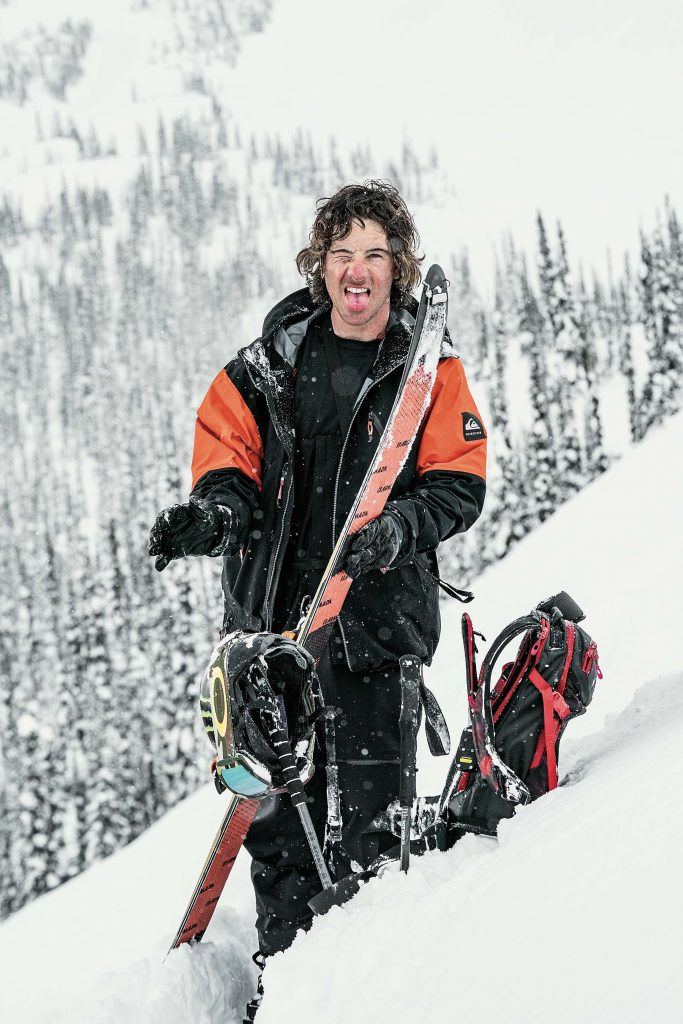
“He’s so motivated and driven. I don’t need to ask him to ski another line—he wants to do it himself,” says Daniel Rönnbäck, a Swedish ski photographer and frequent collaborator.“There’s a handful of skiers that have this drive that I’ve been honored to work with.”
“People don’t see the blood, sweat and tears that go into it. It’s definitely a grind,” Carlson says. Crashing is an occupational hazard—it’s why he hits the gym all off-season. “It’s injury prevention. When you’re strong, you can take those bails.”
But it’s impossible to ski in avalanche terrain, much less ski the way Carlson does, without shouldering risk. His risk tolerance is clearly higher than those content to polish their dad turn in low-angle powder, but, in my limited opinion, it doesn’t seem as extreme as you might expect. Instead, it seems to be tempered with genuine respect for the snowpack—what, when and how Carlson skis is a calculated affair. Still, he acknowledges, “this type of skiing is dangerous…and that’s something that I’m aware of on every line. But I wouldn’t be there if I didn’t feel confident.”
Unsurprisingly, he’s dealt with his fair share of close calls, including when a landing ripped out during a jump build while filming the Sammy C Project in 2015 and a near-death tomahawk down a Revelstoke couloir in 2019. He almost kept the clip of that crash locked in the vault, neither wanting to subject his family to the carnage nor share it with fans. “That’s not the style of skiing I want to put out there. I want to look controlled and comfortable,” he says. “But I think that’s part of something people should know.”In the end, he decided to include the crash in his new movie, for which he chose the name Resilience: It’s both what his skiing career has required and what he wants for the world right now.
“I don’t always show the darker side of the sport,” he says, acknowledging that this film begins to pull back the curtain. “We are pretty stoked to have Resilience as the theme to inspire those watching it to be strong on their path.”
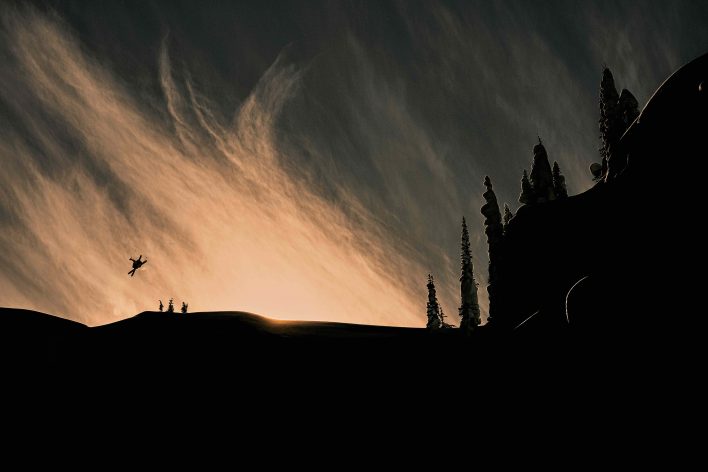
Carlson’s film releases are so impactful partly due to his high standards for what makes an “A-clip,” as well as his enigmatic presence on social media. Today, it seems, lines skied in the morning are teased by the afternoon, but Carlson hoards footage with restraint, and no one outside of his film crew knows what to expect from a Sammy C project. “When he does put something out, I can’t wait [to watch],” Hall says. Instead of chasing trends, Carlson devotes himself to his film projects, and he’s able to do so because of steady brand support.
“My goal is working toward being one of the best skiers in the world,” he says. “I’m lucky to work with brands that give me the freedom and support me as a skier to follow my path and not be confined to a formula—to create content and products that I’m proud of.”
To borrow a comparison from Carlson’s music genre of choice, “Greatest of All Time” conversations in hip-hop center around discography: One-hit wonders come and go, but the best emcees, from Tupac to Jay-Z, fight for their place by compiling a catalog of classics. Carlson quietly stacking clips is skiing’s equivalent of Kendrick Lamar locking himself in the studio. Fans don’t need to see cute pictures of Lamar’s breakfast—they just want the fire alarm to sound when the music finally hits their headphones. In action sports, even viral clips on Instagram eventually fade, but the edits that Carlson is proud of—Resilience, Over Time and their numerous prequels—are full-fledged albums, the bricks that build his legacy.
IN THE MOUNTAINS OF B.C., Carlson’s hunt for clips is a success. Normally, the crew returns to the trailhead after dark, happy to have a shot or two. Today, they have three switch dub nines and three spine lines—six “A-clips” in the bank—all before noon. It’s enough to call it early and let the rest of us score a couple laps. Besides, tomorrow’s forecast calls for bluebird, and they have a heli booked and some driving to do.
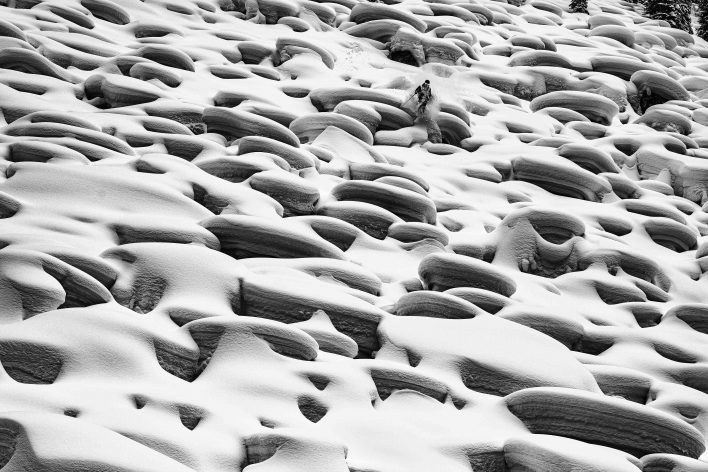
At one point, back on that drive to the airport when I was just getting to know Carlson, I asked him what’s next. “These next few years are about to be my peak. I have a lot more to do,” he’d said. Hall later confirmed this: “Whatever Sammy wants to do, he’s gonna be one of the most comfortable in the world at it at this point.”
I’m happy to know he still has gas in the tank, but it’s hard to imagine what more is on Carlson’s checklist. How can he ski bigger or faster, more technically or creatively? How can he give more to skiing? I ask these questions as an outsider—a snowboarder—who has long been mesmerized by Carlson’s transcendent, savage grace. If there’s one thing I’m sure about, though, it’s that turning A-clips into B-clips is a principle he lives by. This realization comes months after our day in his B.C. honey hole when I get a text. “Btw,” he wrote. “That switch nine didn’t make the flick.”
This article was originally published in Issue #137. To read more, pick up your copy at BackcountryMagazine.com/137 or subscribe.











Related posts: